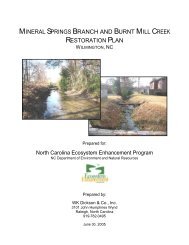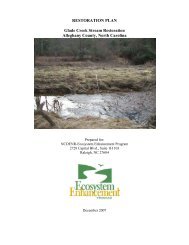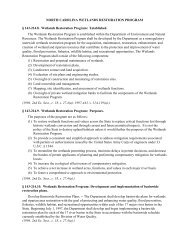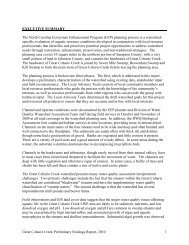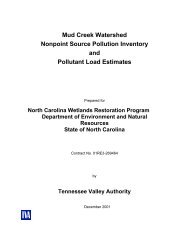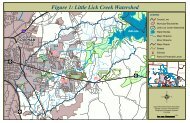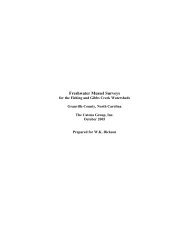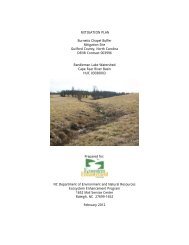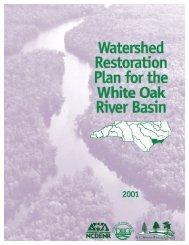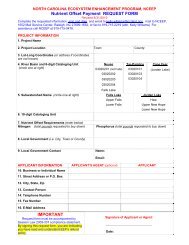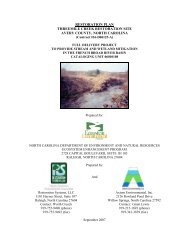Mud Creek Watershed Restoration Plan - Henderson County Center
Mud Creek Watershed Restoration Plan - Henderson County Center
Mud Creek Watershed Restoration Plan - Henderson County Center
You also want an ePaper? Increase the reach of your titles
YUMPU automatically turns print PDFs into web optimized ePapers that Google loves.
themselves and are losing valuable pasture land or crop land as their streams widen and theunstable banks erode – “lose it now or lose it later”. In other cases, structures on the propertymay be at risk due to eroding streambanks. Some landowners may want to improve theaesthetics of their stream or improve wildlife habitat for long-term enjoyment of their property.Landowners must convey a permanentconservation easement on any projectfunded by the NCWRP. Generally, theeasement extends between 25-50 ft fromthe top of the stream banks on both sidesof the stream. The landowner can donatethe easement or NCWRP can purchase theeasement. If the easement is donated, thelandowner may be eligible for a tax creditin addition to other site improvements suchas cattle exclusion and watering systems.Figure 3.8: Site of NCWRP’s Clear <strong>Creek</strong>Stream <strong>Restoration</strong> Project.The NCWRP recognizes that landownerparticipation is a critical component of asuccessful stream restoration project. TheNCWRP is currently implementing astream restoration project in the <strong>Mud</strong><strong>Creek</strong> watershed on Clear <strong>Creek</strong>. TheNCWRP hopes these projects will providelocal landowners with a betterunderstanding of stream restoration. Oncepotential projects sites are identified, theNCWRP will contact landowners todetermine their interest in streamrestoration.Local governments should work with landowners to restore native woody vegetation alongstreams to stabilize streambanks and improve habitat. Full-scale stream restoration is notalways a cost-effective solution to addressing site-specific streambank erosion problems. Inmany cases, these site specific problems can be managed by stabilizing streambanks withvegetation to reduce sedimentation. Buffer restoration costs on average $650-900 per acre andthere are a number of programs in place such as EQIP and Ag Cost Share that provide funding tohelp landowners address this problem. These programs are administered by the <strong>Henderson</strong> Soiland Water Conservation District and the NC Cooperative Extension Service.The IPSI data indicate that over 11% of all riparian buffers of perennial streams in the <strong>Mud</strong><strong>Creek</strong> watershed are inadequate. As is the case with stream restoration projects, there is muchneed for buffer restoration, but little landowner interest to implement this best managementpractice. Local governments will need to identify private landowners interested in bufferrestoration through outreach efforts that could include workshops or newsletter articles.Implementing a buffer restoration project in a city or county park in conjunction with thevolunteer group might also help to bring this issue to the public’s attention.Section 3: Recommendations Page 42




